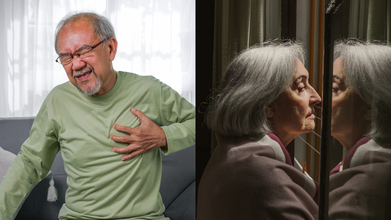- Health Conditions A-Z
- Health & Wellness
- Nutrition
- Fitness
- Health News
- Ayurveda
- Videos
- Medicine A-Z
- Parenting
- Web Stories
DNA Of Longevity: Why Some People Live To 100 And Beyond

Credits: Canva
Ever wondered why some people live well past 100 with their minds sharp and bodies still moving? While external factors like your lifestyle choices, diet, and exercise are important for a long life, science also shows that your genetic makeup may also play an important role for how long you live.
Thomas Perls, who is a professor of geriatrics at the Boston University School of Medicine and direct of the New England Centenarian Study (NECS) explains that longevity can, in fact, be inherited. This is especially the case when we talk about living past 100 years old.
What Makes One A Centenarian?
In the United States, around 1 in every 5,000 people is a centenarian. This means anyone who lives at least 100 years of age. Among them, a striking number are women, making them to be 85% of the total centenarian population. What sets these people apart is not their lifestyle but something beyond the external factors.
As per Perls, centenarians tend to age more slowly and push back age-related diseases like heart conditions, diabetes, or diseases like heart conditions, diabetes, or dementia until their 90s or beyond. This slow aging process is a key to their biological trait among those who reach extremely old age.
Is There A Genetic Link?
Getting to your 90s, Perls says, is roughly 30 percent due to genetics and 70 percent due to lifestyle. But if you’re aiming for 110—the elite club of supercentenarians—that flips: genetics likely accounts for up to 70 percent of your chances.
So, yes, picking the right parents (or grandparents) does matter. NECS has shown that centenarians often come from families where siblings and even parents lived exceptionally long lives. These families seem to carry genetic variations that protect them from aging-related diseases, allowing their bodies to function well even in old age.
One example is Celia, a 102-year-old NECS participant who still played complex Chopin pieces on the piano at public events. She wasn't an exception—many centenarians in the study live independently well into their late 90s or early 100s.
But, Are Genes All?
While you cannot change your DNA, but you can adopt habits that can increase your odds or living a healthier and a longer life. Perls recommends adding these to your routine:
Manage stress: Chronic stress accelerates aging. Finding healthy ways to cope—whether through meditation, community, or hobbies—can slow that process.
Eat smart: A plant-heavy diet with limited meat (ideally only once a week) helps maintain a healthy weight and reduces the risk of chronic illnesses.
Don’t smoke: Smoking is still one of the leading preventable causes of early death.
Exercise regularly: A mix of aerobic and strength training exercises helps maintain muscle, which is essential as you age.
The Older The Better Or The Older The Sicker?
While the common belief is that the older you get, the sicker you become, however, many centenarians reach old age mostly have lived a healthy lives. This is in contrast to people who develop chronic illness in their 60s or 70s. While centenarians often reach their 90s without a major health condition and experience only a short period of illness before their deaths.
This is why the concept of NECS is so valuable. This was funded by the National Institute on Aging, the William M. Wood Foundation, and the Martin and Paulette Samowitz Family Foundation. The study has tracked more than 2,000 centenarians, identifying not only genetic patterns but lifestyle commonalities.
This Common Pill May Cut Breast Cancer Risk in Women, New Study Finds

Credits: Canva
Scientists have found that a type of morning-after pill may help protect young women from developing breast cancer. The drug, which is already available for free on the NHS, blocks the hormone progesterone and has been shown to trigger changes in breast tissue that make it less likely for cancer to form. One woman who chose to undergo a double mastectomy as a preventive measure says the discovery “offers hope” to others at high genetic risk of the disease.
A team from Manchester University studied 24 women between 2016 and 2019 who were at high genetic risk of breast cancer due to family history. These women, aged between 34 and 44, took ulipristal acetate, and researchers observed that their breast tissue became less dense and less stiff, conditions that make it harder for cancers to grow.
What Is Ulipristal Acetate?
Ulipristal acetate is commonly prescribed as emergency contraception and to treat moderate to severe uterine fibroids. It works by blocking progesterone receptors, delaying ovulation, and altering the uterine lining to prevent pregnancy, as per 1mg.
Earlier research has also shown that triple-negative breast cancer tends to return or spread more quickly than other breast cancer types, especially within the first few years after diagnosis.
Is Ulipristal Acetate A Promising Step Toward Prevention?
Dr Sacha Howell, lead author of the study and Consultant Oncologist at The Christie Hospital in Manchester, said, “Our research shows that progesterone has a vital role in the development of breast cancer among high-risk women. By blocking its effects, ulipristal acetate and similar drugs could serve as effective preventive treatments,” he explained.
The findings suggest that using ulipristal acetate to prevent breast cancer may one day help women at higher risk before menopause.
Currently, these women face only two preventive options: long-term hormone therapy, which can cause side effects like higher blood clot risk and reduced bone density, or preventive surgery to remove part or all of the breasts.
The Need for Better Options
Dr Simon Vincent, chief scientific officer at Breast Cancer Now, which funded the study, said, “We urgently need better preventive treatments that protect both health and quality of life for women at high risk of breast cancer. Repurposing existing medications, like ulipristal acetate, could be a major step forward. Right now, the available options—preventive surgery or hormone therapy can have a serious impact on both the body and emotional wellbeing.”
The study, published in Nature, found that ulipristal acetate reduced the growth of certain breast cells known as luminal progenitors. These cells can develop into triple-negative breast cancer, an aggressive form of the disease that often affects younger and Black women.
Disclaimer: This article is for informational purposes only and should not be taken as medical advice. Always consult a qualified healthcare professional before starting, stopping, or changing any medication or treatment.
These 11 Factors Could Help Diagnose Dementia At An Early Stage, Says Study

A recent study has listed 11 risk factors that could reveal your risk of developing dementia. As you may know, dementia affects millions of people throughout the world. According to the World Health Organization in 2021, 57 million people worldwide lived with dementia, and about 60% of them lived in low- or middle-income countries.
Dementia, like many other conditions, does not have a cure, so its treatment involves delaying the onset of symptoms. The best way to ensure the symptoms stay under control is by getting an early diagnosis. However, the visible effects of conditions like dementia take a long time, they only become obvious when the disease has affected your body for a long time.
With the help of these risk factors, published in the BMJ Mental Health, people can work on reducing their chances of developing dementia.
11 Key Risk Factors of Dementia
To help people know if they are at high risk and inspire them to make changes, UK researchers have developed a new tool. This tool, called the UK Biobank Dementia Risk Score (UKBDRS), uses a set of characteristics to correctly predict up to 80% of dementia cases. Researchers believe that using this score could help prevent up to 40% of future dementia cases.
Researchers tested 28 different factors linked to dementia but found that 11 characteristics stood out as the most important predictors. These 11 factors include a mix of things we can change and things we cannot change. The new factors identified in the study, published in BMJ Mental Health, are:
- Age
- Education
- Family history of dementia
- Poverty
- History of diabetes
- Stroke
- High blood pressure
- Depression
- High cholesterol
- Being male
- Living alone
This new score was found to be just as effective as, and even outperformed, three other widely used dementia risk tests.
Who Is More At Risk For Dementia?
Some of these factors, like age and a family history of dementia, have long been known to increase risk. However, the study highlighted some newer or previously less emphasized risks:
Men were found to be more susceptible to dementia. While historically women have had higher rates, men often face increased risks for heart and blood vessel problems like cardiovascular incidents and tend to visit the doctor less often. Lifestyle habits more popular among men, such as smoking and heavy drinking, can also raise the risk.
Regardless of gender, living alone and living in poverty also increases the likelihood of cognitive decline. Feeling lonely can raise the risk of dementia by as much as 31% in older adults. Not having enough basic necessities, like food or shelter, can increase chronic stress, which is linked to higher rates of dementia.
While these new factors are very promising for predicting future cognitive health, it's important to note one limitation of the study: the participants were not officially diagnosed using the standard clinical assessments.
Despite this, the findings are helpful. People who score highly on this risk test, meaning they have several of the 11 risk factors, may benefit from seeing a doctor for additional testing and early intervention as more research is done.
Molecule: The Controversial Weight Loss Pill Is Going Viral in Russia—But Is It Safe?

Credits: Canva
A small blue pill called Molecule has become a major trend among young people in Russia, especially on TikTok, where it is hailed as a quick fix for weight loss. Marketed as a “natural supplement” made with dandelion root and fennel seed extract, it has drawn huge attention for its low price and bold promises.
But independent testing has uncovered a troubling truth — the tablets actually contain a banned substance linked to a higher risk of heart attack and stroke, and is baned in the US, UK, EU, and China.
What Is Molecule?
Earlier this year, Molecule swept through Russian TikTok, promoted as a fast and easy way to lose weight. Feeds were filled with videos captioned “Take Molecule and forget food exists” or “Do you want to sit in the back of class wearing oversized clothes?” Fridges lined with the pill’s distinctive blue boxes, featuring holographic “Molecule Plus” labels, became a status symbol.
Orders began flooding in as teens proudly documented their “weight-loss journeys.” But soon, the excitement gave way to alarm. Users began reporting severe side effects. Maria, a 22-year-old, told the BBC that after just two weeks, she experienced extreme anxiety, dehydration, and a complete loss of appetite. Others complained of insomnia, shaking hands, and dilated pupils. Several school students were eventually hospitalized.
What Does Molecule Contain?
Despite its packaging listing herbal ingredients such as dandelion root and fennel seed, a report by the Russian newspaper Izvestiya revealed that Molecule actually contains sibutramine, which is a prescription-only appetite suppressant known to raise the risk of heart attack and stroke. Sibutramine was banned in the United States in 2010 and is also illegal in the United Kingdom, the European Union, and China.
What Is Sibutramine?
Sibutramine is an appetite-suppressing drug once prescribed for obesity. It acts as a serotonin-norepinephrine reuptake inhibitor (SNRI), increasing feelings of fullness and reducing hunger. Although it proved effective for weight loss, it was withdrawn from global markets after studies showed it could significantly increase the risk of serious cardiovascular problems, including heart attacks and strokes. The risks were deemed too high, especially since many people seeking weight-loss treatment already face heart-related health concerns.
Is Molecule Similar To Weight-Loss Drugs Like Ozempic or Wegovy?
While Ozempic and similar injections are medically approved and work by targeting gut hormones that regulate appetite and blood sugar, Molecule is an unregulated supplement containing a banned chemical. It has never undergone safety testing, and it is sold freely without medical oversight or prescription.
How is Molecule Still Being Sold in Russia?
Although sibutramine is legally available in Russia only through prescription for adults with obesity, Molecule is sold openly online, often in higher doses and without supervision. Even after e-commerce sites removed listings, it quickly resurfaced under new names like “Atom,” disguised as diet biscuits or even packaged to look like lightbulbs, as per the BBC report.
A 20-day supply costs only £6–7 (around ₹700), compared with the £40–160 (₹4,000–16,000) monthly price tag of Ozempic shots in Russia. Its affordability and strong presence on social media have made it particularly appealing to teens chasing unrealistic body ideals.
For now, Molecule remains popular across Russia’s online weight-loss market. It is cheap, accessible, and heavily promoted. Yet beneath the glossy marketing and viral videos lies a serious health threat. The so-called pill “to forget food exists” could well become another warning about the dangers of fast-track weight-loss solutions in a culture fixated on instant change.
© 2024 Bennett, Coleman & Company Limited

